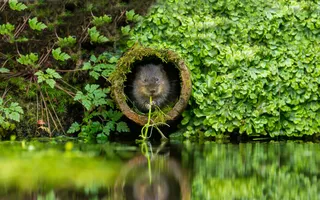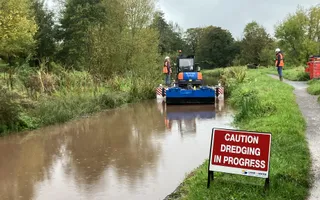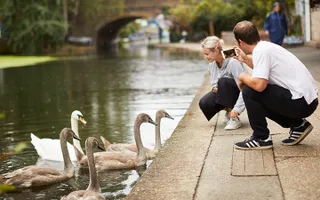New Zealand pigmyweed, also known as Australian swamp stonecrop, was originally sold in garden centres as an ‘oxygenating plant’. It grows all year round and can quickly smother native vegetation.
New Zealand pigmyweed facts
Scientific name: Crassula helmsii
Family: Crassulaceae
Native to: Australia, New Zealand and Tasmania
Type: Perennial
Which species eat it? Grass carp do, but it is not a primary food source for them
Location: It can grow on land, as well as above and below water. It is found in canals and rivers, and open water spaces like reservoirs and lakes. Damp, muddy patches and pond margins are its preferred terrestrial locations.
New Zealand pigmyweed in Britain
New Zealand pigmyweed was originally introduced to the UK in the early 1900s as an oxygenating plant for ponds. Able to grow from fragments as small as 1cm, it reached the wild through a combination of people disposing of their pond water, and by hitching a ride on pond-dwelling species.
Due to its negative impact on native flora and fauna, New Zealand pigmyweed is listed under Schedule 9 of the Wildlife and Countryside Act 1981, meaning it is illegal to cause it to grow in the wild.
Why is New Zealand pigmyweed a problem for canals and native wildlife?
The weed has the potential to cause havoc along our canals and rivers. It forms a dense mat over the water's surface that blocks out light and oxygen, killing anything living beneath it and blocking navigation.
Its dominating presence displaces other aquatic plant species, which in turn affects food webs and ecosystems.
Amphibians like frogs and toads, as well as waterfowl like coots, moorhens and ducks, are all impacted by New Zealand pigmyweed's ability to smother the surface of a waterbody. With it being able to grow to depths of three metres below water, fish are also at risk of suffocation as a result of insufficient oxygen levels.
Boaters and other craft users can face problems from it tangling in propellers and oars. Similarly, those who are fishing can have issues with their rods and equipment.
What does New Zealand pigmyweed look like?
In its terrestrial form, New Zealand pigmyweed grows away from the water's edge. Its small, narrow leaves appear fleshy and tough, measuring about 2cm long. They grow in opposite pairs and are tightly packed all the way up the stem.
When completely submerged, its leaves are much more sparse and flat, with significant space between pairs.
In between that, in its emergent state, the leaves appear much the same as when it's fully terrestrial, although they will be mostly submerged in the water.
Small flowers grow from the top of the stem. These have four petals and are usually a white-green colour, but can also be tinged with pink.
How do you remove New Zealand pigmyweed from canals?
Once New Zealand pigmyweed becomes well established, it can be practically impossible to eradicate. The best time of year to attempt any removal is late autumn.
As its roots remain shallow in the water, dredging using specialist machinery is the most effective method of removal, alongside pulling by hand. It is not advised to cut the weed, given that it has the potential to spread from tiny stem fragments.
Any New Zealand pigmyweed that's removed should be composted. A hot compost heap will destroy all the plant fragments.
How to report invasive species
If you see an invasive, non-native plant species on one of our canals or rivers, please contact us online or call us on 0303 040 4040 and we'll check if it is already included in our treatment schedule.
How you can help prevent the spread of invasive species
Various invasive plant and animal species can be transported on equipment such as paddleboards and oars, and wet clothing including footwear.
Whether you use our canals and rivers for work or pleasure, please remember to Check, Clean, Dry.
These three things should always be done before you leave a waterway, even if you are moving to another spot on the same stretch just a few miles away.
Other invasive species on our canals









